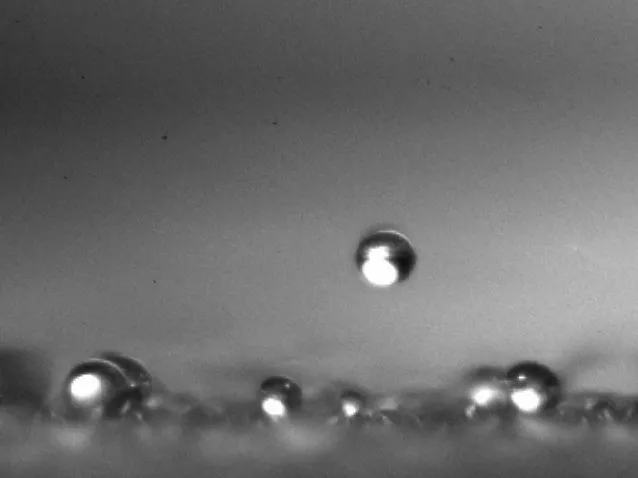When you have wet skin, you no doubt notice a cooling sensation as it dries. This is because the water droplets are carrying heat away from your skin with them, as they evaporate. Phase-change thermal diodes work the same way - through an evaporation and condensation process, they use liquid to transport heat away from things such as microchips. In most of these diodes, liquid placed on a hot surface evaporates, the vapor then rising onto a cooler surface, where it condenses back into liquid. In a closed-loop cycle, gravity subsequently carries that condensate back down to the hot surface, so it can once again be evaporated. Now, scientists from North Carolina's Duke University have discovered a method of getting condensed water droplets to jump back to the hot surface - and they can do so in any direction, including straight up.
The Duke experiments involved two copper plates, one of which was coated with a superhydrophobic (highly water-repellent) material, and the other with a superhydrophilic (highly absorbent) material. Water that was applied to the superhydrophilic plate would initially stay put, but then evaporate as it got hotter. Because the two plates were located face-to-face with only a 1.6-mm gap between them, the water vapor was able to travel up, sideways or even down onto the cooler, superhydrophobic plate, which it would condense onto.
While the tiniest of the droplets would stay on this cooler surface, once two of them joined together into one larger droplet, that droplet would become subject to the surface's water-repellent qualities. This would cause it to jump off of that surface, and back onto the hot, superhydrophilic plate, so the whole process could take place over again.

"When the superhydrophobic surface is colder than the superhydrophilic surface, the heat transport is very effective with phase-change processes, much like sweat taking away body heat; when the superhydrophobic surface is hotter, the heat flow is blocked and the diode behaves like a double-paned window," said project leader Chuan-Hua Chen, assistant professor of mechanical engineering and materials science. "Because the jumping droplets in our system are very small, gravity has a negligible effect on them. Therefore, devices based on this approach can be oriented in any direction without the need to worry about gravity."
Conventional phase-change thermal diodes are affected by gravity, as the condensate relies on it to trickle back down. Tubular diodes get around this problem, but their shape limits their applications. The jumping-droplet diodes, however, could be produced in any number of shapes.
Chen added that the technology is also very scalable, so it could be used in everything from computer chips to solar panels to the roofs of buildings.
A paper on the Duke research was recently published in the journal Applied Physical Letters.




